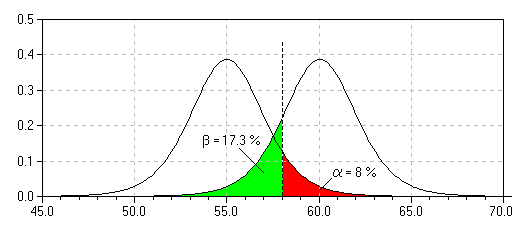 You are working with the text-only light edition of "H.Lohninger: Teach/Me Data Analysis, Springer-Verlag, Berlin-New York-Tokyo, 1999. ISBN 3-540-14743-8". Click here for further information.
You are working with the text-only light edition of "H.Lohninger: Teach/Me Data Analysis, Springer-Verlag, Berlin-New York-Tokyo, 1999. ISBN 3-540-14743-8". Click here for further information.
 You are working with the text-only light edition of "H.Lohninger: Teach/Me Data Analysis, Springer-Verlag, Berlin-New York-Tokyo, 1999. ISBN 3-540-14743-8". Click here for further information. You are working with the text-only light edition of "H.Lohninger: Teach/Me Data Analysis, Springer-Verlag, Berlin-New York-Tokyo, 1999. ISBN 3-540-14743-8". Click here for further information.
|
| See also: Types of Error |   |
The power of a statistical test is defined as the probability of correctly rejecting a false null hypothesis. Power is therefore defined as: 1 - b, where b is the Type II error probability. A test with a low power is of little worth, although the level of significance a may be high (the results are inconclusive).

Note that for a given set-up of an experiment, the power of a test and
the level of significance are related to each other: decreasing the level
of significance a (which is favorable, since
the probability of making an error when rejecting the null hypothesis is
lowered) also decreases the power of a test (which is bad, since the probability
of making a type II error increases). Thus, without changing the experiment,
we have to make a compromise between a low level of significance and the
high power of the test.
Last Update: 2004-Jul-03